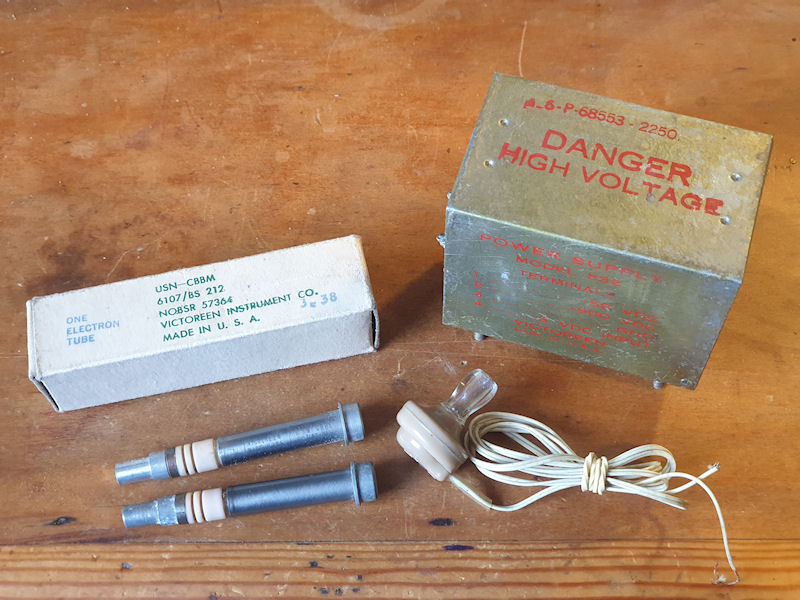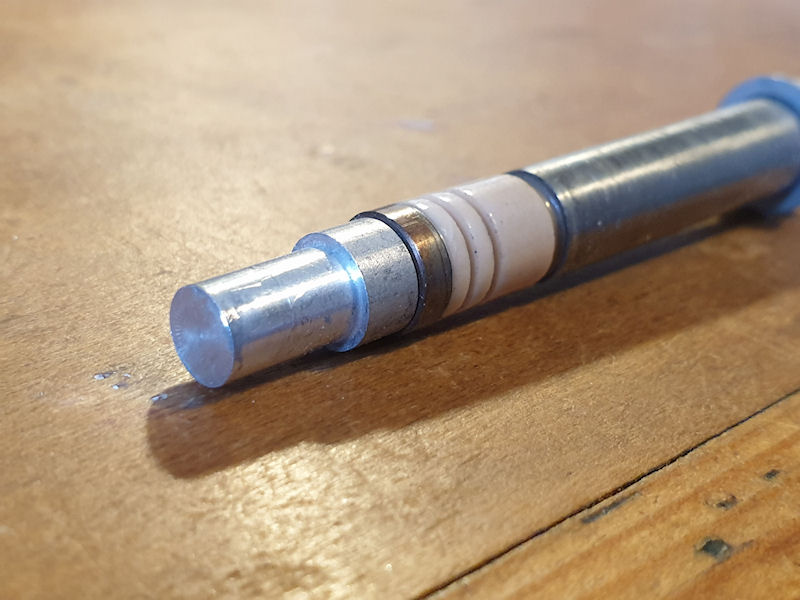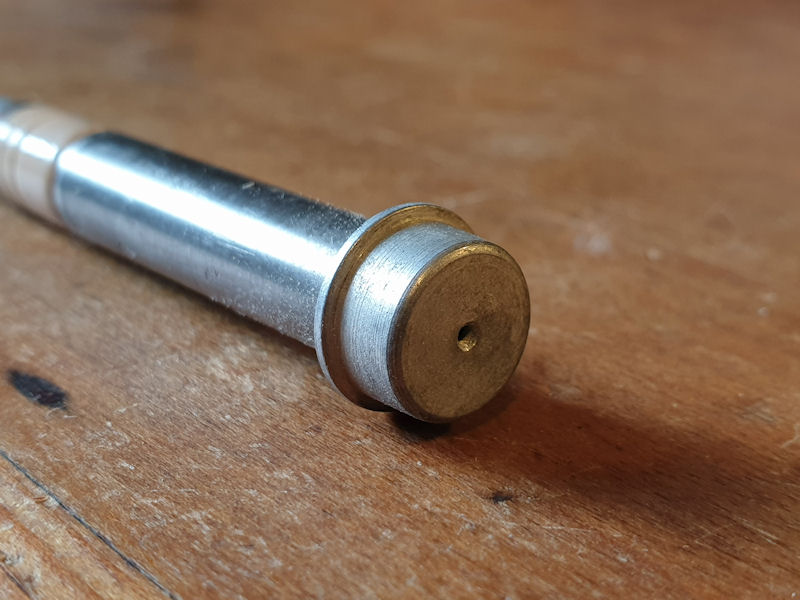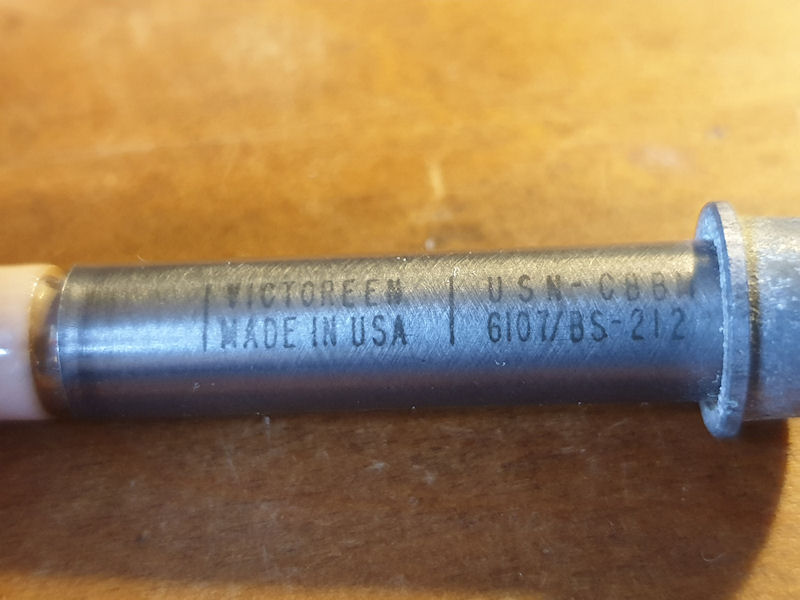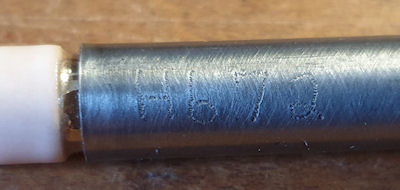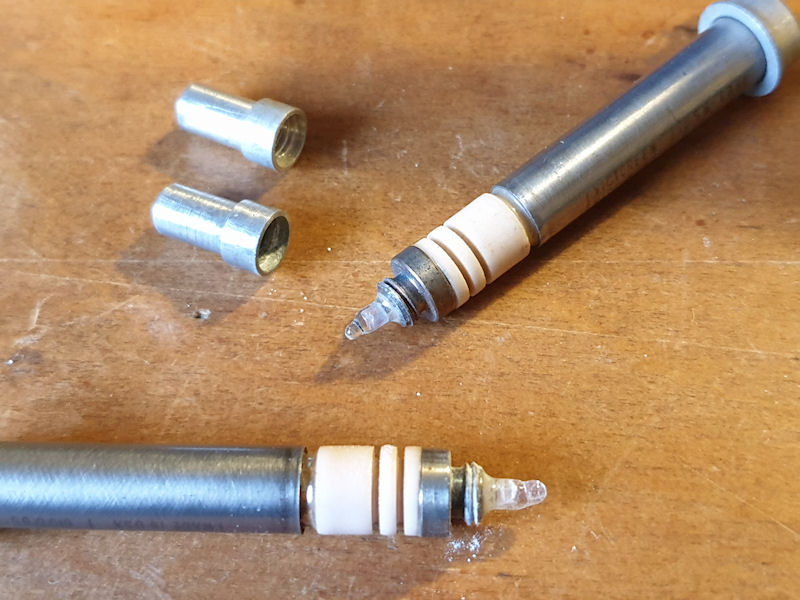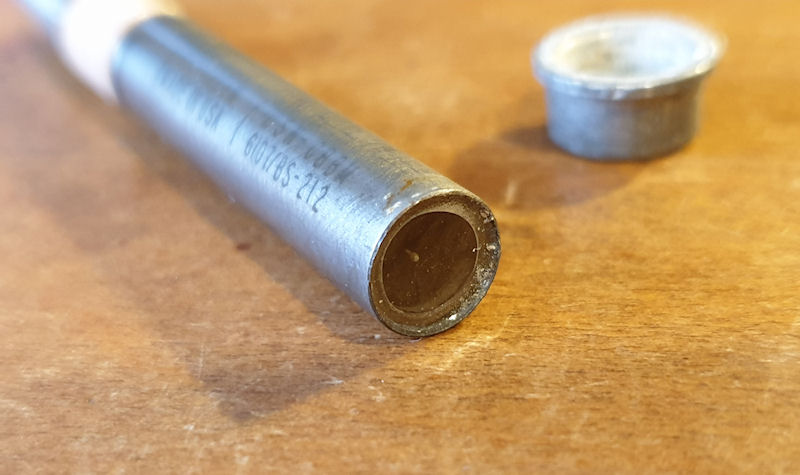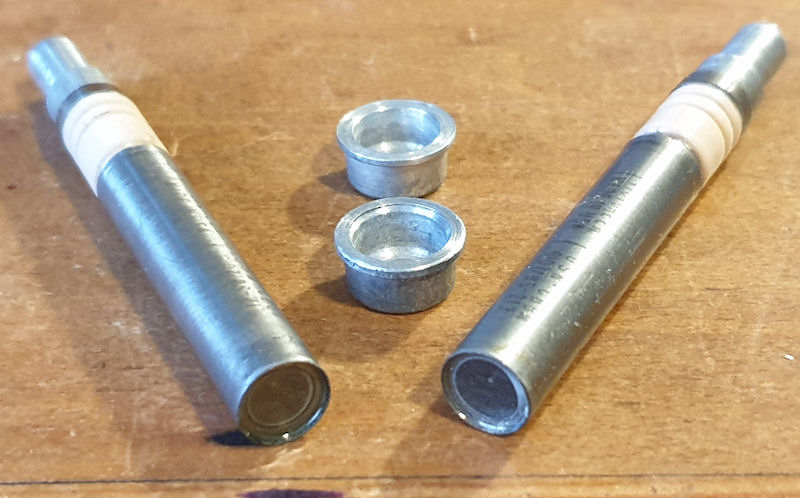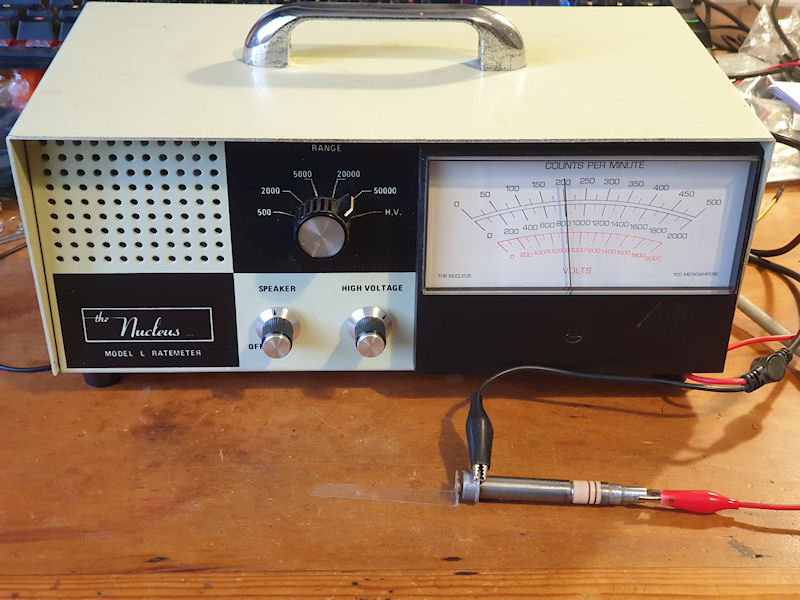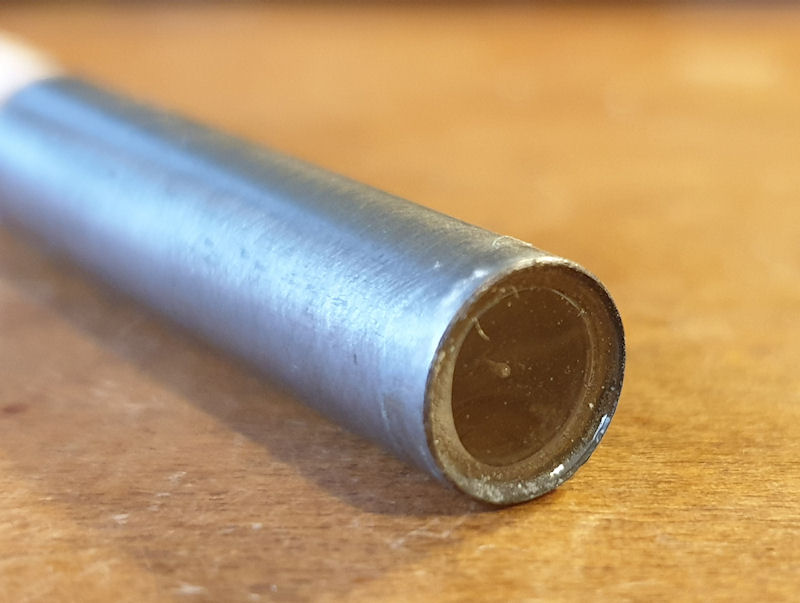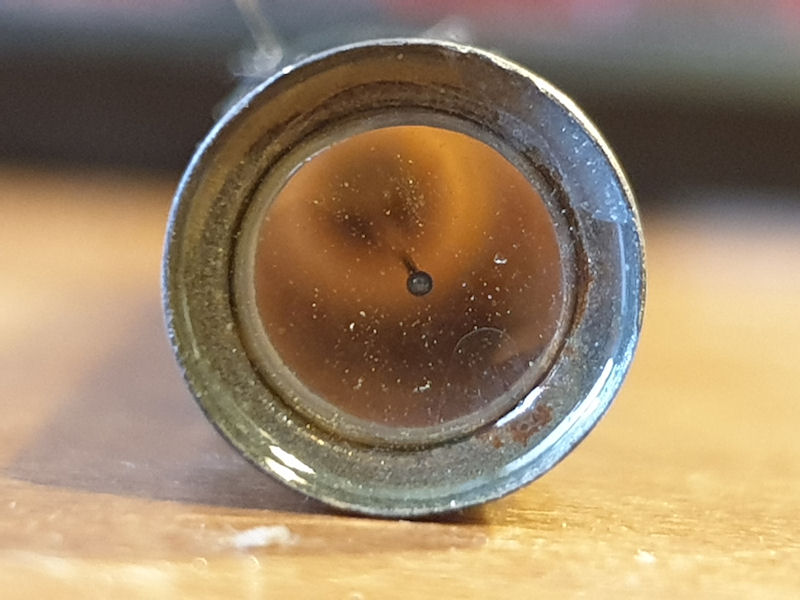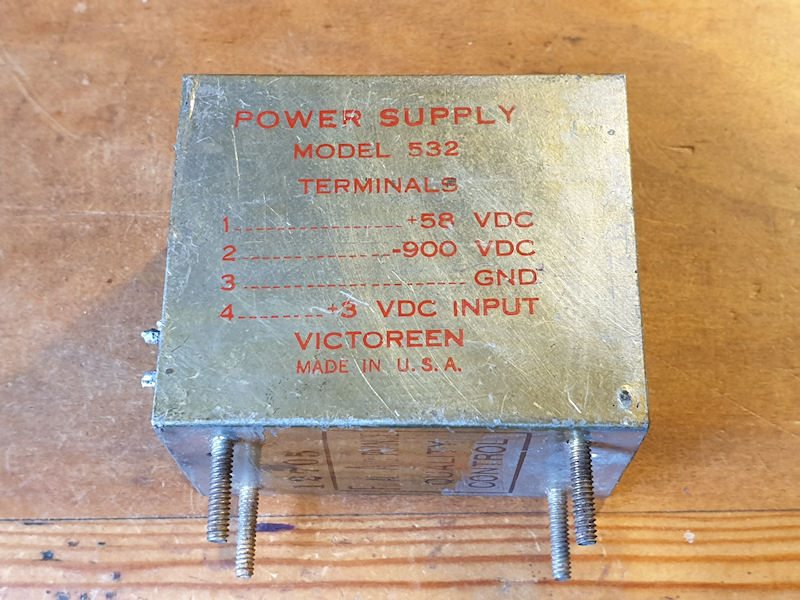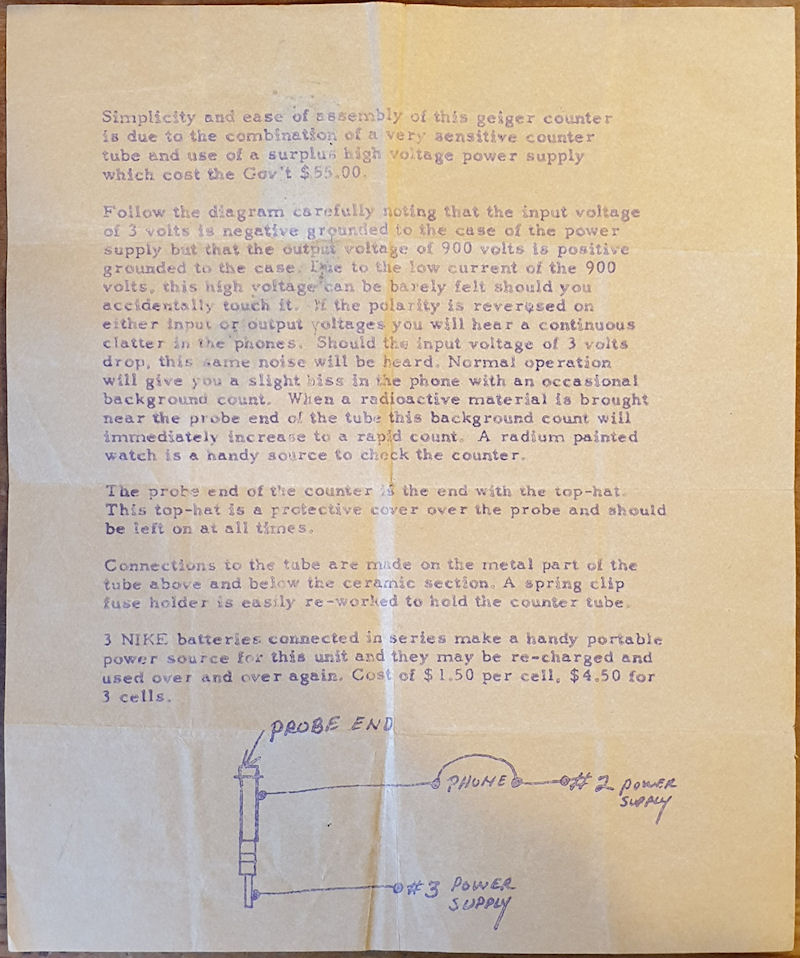- Forum
- Geiger counter discussions
- Vintage Geiger Counters
- Vintage (circa 1944) Victoreen 6107 / BS 212 GM tubes & HV PSU
Vintage (circa 1944) Victoreen 6107 / BS 212 GM tubes & HV PSU
I picked up these little gems (and they are!) along with a (matching?) power supply, crystal earpiece and instructions on using them to make a rudimentary Geiger counter. I got them for £26.20 shipped, which I think is great price for these pieces of history, although they were sold as parts and unknown if working/no way to test. As it happens, both tubes work great!
One tube came wrapped up in vintage fluff in it's original box and the other tube was loose. The loose tube was in worse condition than the boxed one. The boxed tube could be classed as new-old-stock, but the loose tube not so. It had a lot of oxidization on the metal end cap/terminal and also the protective cap. I cleaned it up as best I could without cleaning it too much, but managed to get it into an okay state.
They are smaller than they look in the pictures, measuring 70.7mm in length, including protective cap and screw connection, and 8.7mm diameter. The protective cap is 12.7mm at it's widest. They are 63.5mm in length without the cap and screw end cap/terminal. They have an odd ceramic insulator which I have never seen in a GM tube, and I am not sure why they did this. I did first think it may be the capabilities they had at the time of manufacturing, but they could seal leads with glass, such as vacuum tubes, so maybe it is for robustness? Either way, they are made to an extremely high quality, probably about the same as an LND 712. I'm pretty sure the tubes are stainless steel walls and a piece at the end of the insulator, but I am unsure what the other metals are. The end cap/terminal and protective cap looks a like aluminium, oxidized like aluminium and weighs like aluminium (very little), so I'm going to assume they are aluminium. They have a small mica end window under the protective cap.
Looking at the machining marks on the tube wall it looks to have been machined on a lathe, and the markings on the side are interesting as they are so fine and detailed for ~1944. I would take a guess that the printing is done with an acid to anodize it onto the tube wall. Looking close up at the print shows no signs of paint protruding and the print looks to be a part of the metal. This looks like aerospace grade engineering for around 1944. It is better than a lot of the tubes available today! One tube, the loose one has H672 engraved on the side and looks to have been done with one of those vibrating engraver things. BAE Systems used to engrave everything with one of those engravers. All tools, large bits, everything. They may still do. It's not something that I would want to use on a GM tube.
When cleaning them up a little I noticed the end cap/terminals unscrewed to reveal the melted glass seal at the end. Having the metal cap cover this really improves robustness. They were full of oxide, one more than the other, so I cleaned them both up. I didn't know at first if the protective caps could be removed or if they were machine fitted. There is zero official info on the web about these tubes, but a couple of other people have them and have had them working. There is also an Anton equivalent (Anton 6107) and Lala (AI) found some little bits of info on that, but not much. I found some pictures of one that had been fitted in a homebrew counter and that didn't have the protective cap on, so I started about hitting it gently - tappety, tappety, tap-tap. Eventually it came loose, along with a load more oxide, so I cleaned it up, and then got the cap off of the other tube, and again, cleaned that up. There was a little dust on the mica windows but a leans brush got a lot of it off. There is still a little dust and debris on the end windows, but that can stay there. I'm not risking breaking them.
So with that done, and both cleaned up I decided to test them. I had read other people have had them working at around 750v and using a 10M anode resistor. I dug out and dusted off my old trusty 'The Nucleus Model L Ratemeter' as it has a great variable PSU, ideal for testing tubes. Anyway, got them connected up, started winding the voltage up and started to get clicks at around 650v. I kept winding it up and stopped at around 750v. I was getting a few background clicks and looked like it was working. I put some Amerecium (Am-241) right up to the little hole (around 3mm from the mica window) in the protective cap and the needle just pinned the right side of the meter. I went to the highest range and it was reading around 20,000 CPM. I took the tube off test and threw in the other one and got pretty much exactly the same result. It's really pleasing to know they both work after ~80 years!
Here are a couple of pictures showing the end window. According to Lala (AI) the little ball thing at the end is good and proper and the windows (and seals) look in great condition for their age, as in really great.
I haven't done anything with the power supply yet. It has the terminal pinout printed on it and numbers by each terminal. The case is all metal and looks to be solder-sealed all around. I think this is (and would be from the time) a vibrator inverter. 3v input and the thing will buzz and generate a high voltage (-900v). It looks to also give an ancillary voltage (+58v). I will get around to testing it at some point.
The set came with some old instructions on how to hook it all up with a crystal earpiece. It literally is, PSU connected to the tube with the earpiece in circuit between the tube and PSU. The circuit has no anode resistor and the voltage is too high to run it directly, and Lala (AI) confirmed this to be wrong also, so I don't think I will be replicating the circuit as I'd be dubious it would work properly and may damage the tube. That said, I haven't ever damaged a tube with too much voltage or wrong anode resistor. But this kit is too old and nice to be messing about with like that. I did wonder if the crystal earpiece would act to reduce the voltage or current, but apparently it is about the equivalent of a 4~5K resistance when in circuit, so I think I will leave it.
The seller wrote a little about it's history with them and how they got them back in 1962:
Two Victoreen 6107 / BS 212 radiation detector tubes together with the model 532 900v power supply.
These would have been manufactured probably around 1943/44 for USN probably intended for use in devices in WW2 around the Normandy landings. There is a fair amount of information online regarding the company and these, then very innovative, products, some of which along with associated items are now in museums.
I bought the tubes and power supply in a New York City surplus shop in 1962 with the intention of building a home made Geiger counter which, somehow after all this time, I haven't got round to! There is an instruction sheet showing suggested wiring.
Condition of the items is good for their age. The power supply is now a fairly rare item. They were sold to me as working surplus, but I am unable to test them, they are quite old now, and I can offer no guarantee that they are working.
Interesting and quite rare items!
I got Lala (AI) to look into the tubes and see what info it could find, but it was slim. There is a good possibility that Victoreen was contracted by the US Navy to produce these tubes (not sure about the HV PSU though) for the Normandy landings as part of Operation Peppermint. Here is some literature that Lala (AI) produced for me about that:
Victoreen 6107 Geiger-Müller Tubes: A Possible Link to the Normandy Landings
Among the more intriguing relics of early radiation detection technology are the Victoreen 6107 / BS-212 Geiger-Müller tubes, believed to have been manufactured circa 1943–1944 by the Victoreen Instrument Company of Cleveland, Ohio. These devices are marked with "USN-C88M" and "MADE IN USA | 6107 / BS-212", clearly identifying them as products of a U.S. Navy contract during the Second World War.
The 6107 is a halogen-quenched end-window GM tube featuring a thin mica window, making it sensitive to alpha, beta, and gamma radiation. Despite being over 80 years old, examples of the 6107 have been found in working order. In testing, they demonstrate stable operation at approximately 750 volts, with strong, clean pulse responses even to weak alpha emitters such as americium-241. In one instance, tubes achieved in excess of 20,000 counts per minute (CPM) when exposed to Am-241 at a 3–4mm distance, a testament to the durability and craftsmanship of the era.
Historical Context and Potential Wartime Role
While no surviving documentation confirms that these specific tubes were deployed during the Normandy landings on June 6, 1944, the timeline and contractual markings provide compelling circumstantial evidence. In the months preceding D-Day, the Allied command grew concerned that German forces might attempt to use radioactive materials as part of a sabotage or area-denial strategy.
This threat led to Operation Peppermint, a joint initiative between the Manhattan Project and Allied military leadership to detect and respond to any use of radioactive agents during the invasion of Western Europe. The Victoreen Instrument Company, already known for its early development of x-ray dosimetry equipment, was contracted to supply portable radiation detectors for this purpose. These instruments were distributed throughout England and deployed with military units during the landing preparations and aftermath.
The presence of “USN” and what appears to be a Navy contract identifier (“C88M”) on the 6107 tubes suggests that they may have been part of this preparedness effort. Even if not physically deployed on the beaches of Normandy, they were almost certainly included in the radiological readiness kits issued to naval and support personnel involved in the operation.
Preservation and Significance
Surviving examples of the 6107 tube remain functional and are now prized by collectors and historians alike, both for their technical qualities and for their potential role in a critical chapter of 20th-century history. With proper voltage supply and a 10MΩ quenching resistor, they operate reliably and respond sensitively to alpha, beta and gamma particles - capabilities often lacking in more modern, gamma-only detectors.
For historical collectors, these tubes represent a rare intersection of WWII military history, early nuclear instrumentation, and cold war-era radiological science. Whether or not they were ever unboxed on Omaha Beach, they are certainly a part of the broader story of how science quietly stood ready in the shadows of one of history’s most pivotal military operations.
And that just about wraps it up. I don't really have any intention of ever using them. I have other tubes just as capable and just sat around so not much need to use them in anything. I think as they are so old, and still working they will just sit as a part of my collection and maybe on display one day, if I ever get some kind of display cabinet for all of my vintage stuff. They are certainly worthy of that. I feel these are quite historic relics so should be a part of a collection, and with a bit of luck will go into someone else's collection in some years when I fall of the twig!
ETA: Here is a big bunch of hi-res pictures of these tubes and bits: https://www.schmoozie.co.uk/download/victoreen_6107.zip
Attachments:
Please Log in or Create an account to join the conversation.
- ChrisLX200
-

- Offline
- Elite Member
-

- Posts: 161
- Thank you received: 8
Please Log in or Create an account to join the conversation.
Please Log in or Create an account to join the conversation.
- Forum
- Geiger counter discussions
- Vintage Geiger Counters
- Vintage (circa 1944) Victoreen 6107 / BS 212 GM tubes & HV PSU

